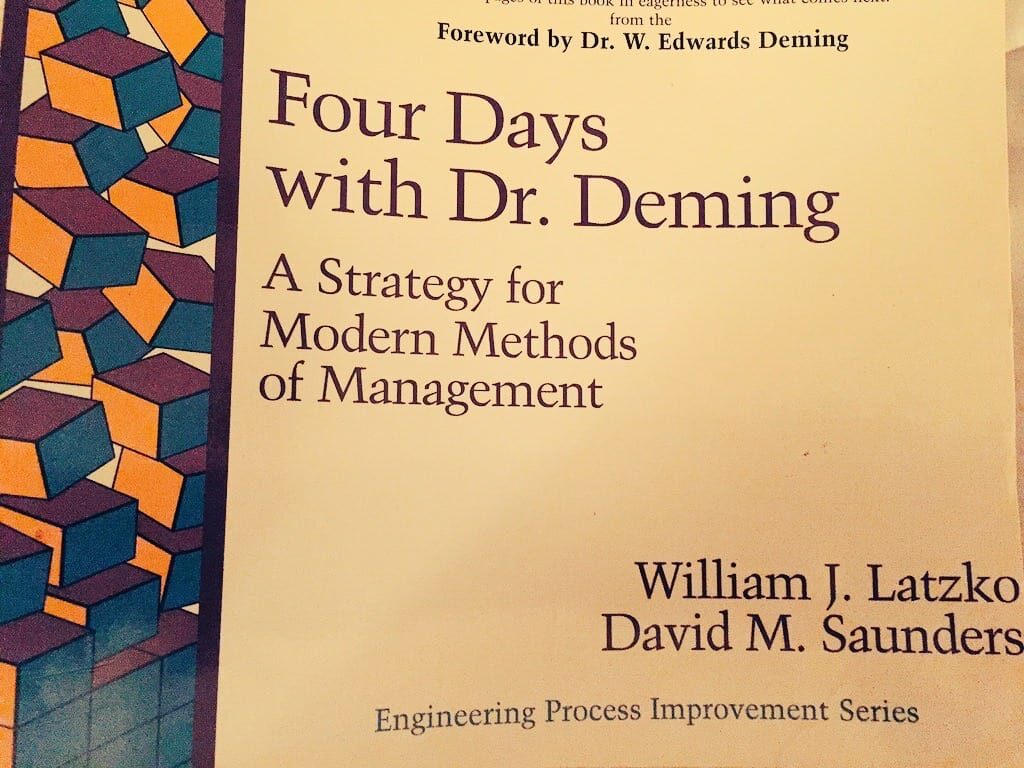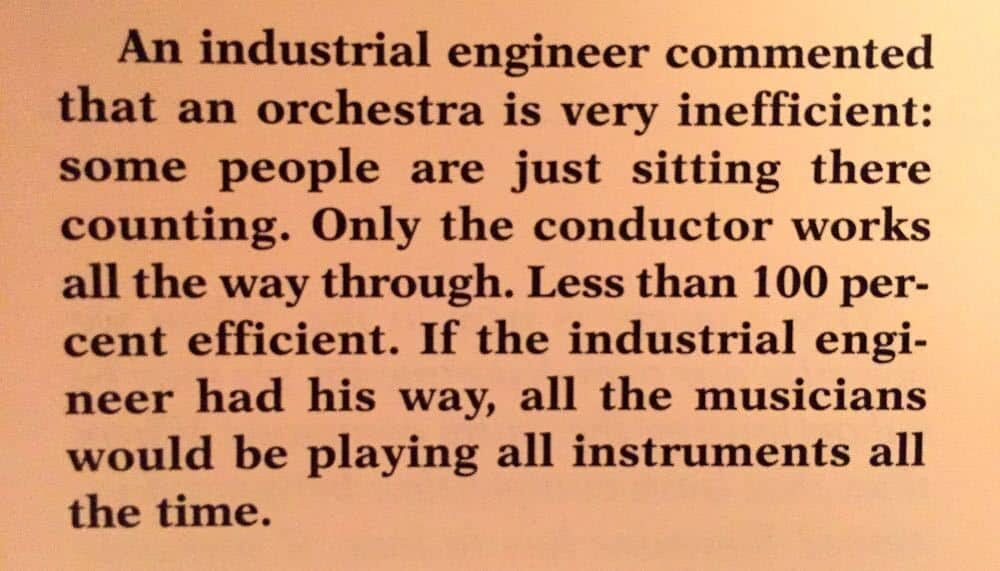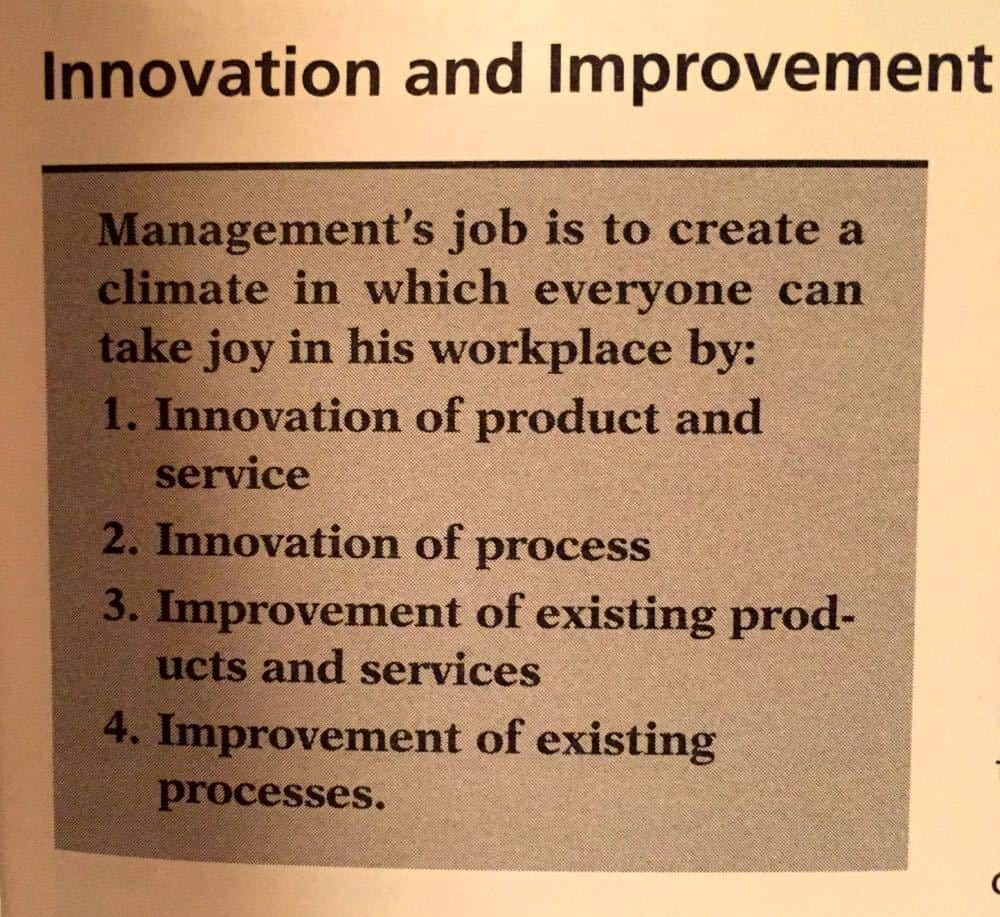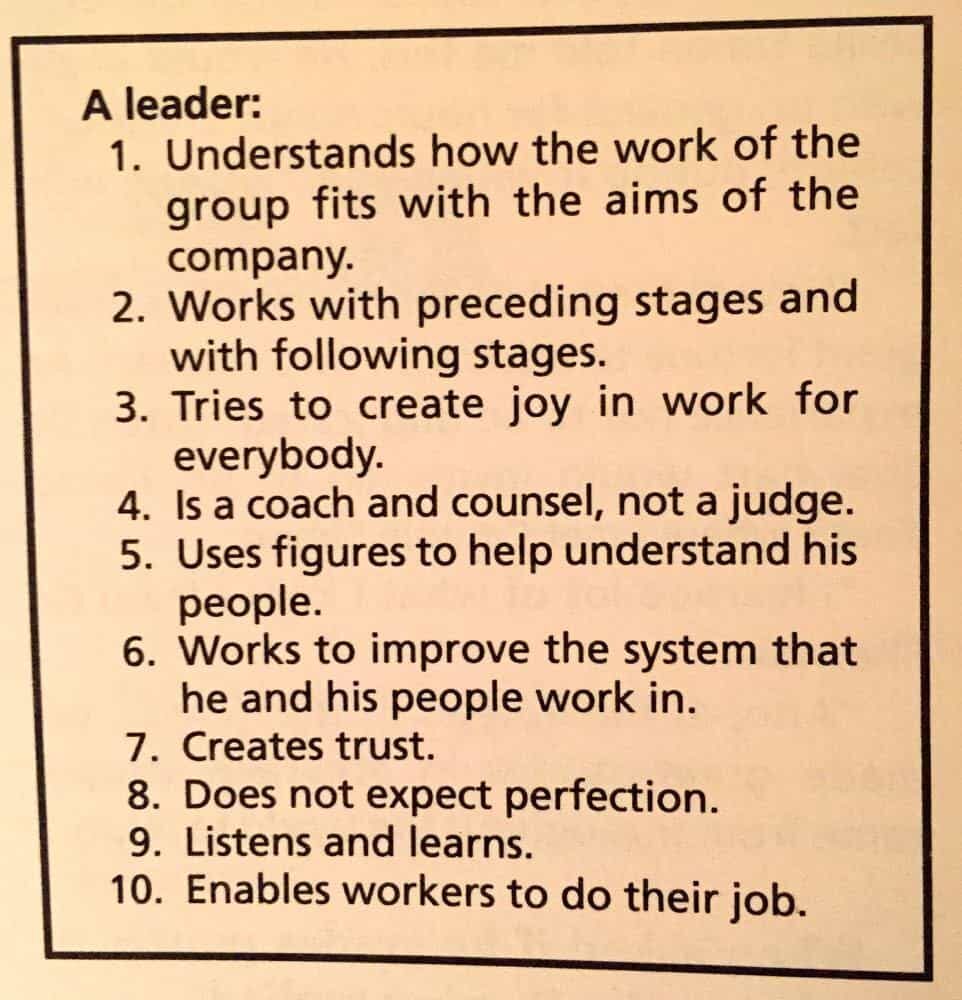I had planned on chilling out over the holidays by reading some books that aren't related to Lean, Kaizen, etc. Novels are not normally my thing and I started reading How Doctors Think, which had been on my Kindle to-read list for a while. It stopped reading after about four chapters…. I might pick it up again at some point. It was just OK. Interesting, but not riveting.
I ended up nerding out and reading a paperback I had purchased a while back: Four Days with Dr. Deming: A Strategy for Modern Methods of Management.

It's an interesting format. William J. Latzko and David M. Saunders worked with Dr. W. Edwards Deming and assisted in his famed four-day seminars. Latzko and Saunders, with Deming's blessing, created this book as a narrative of those four days.
From Latzko's LinkedIn bio:
At the time that he developed the theory of management, Dr. Deming had a number of collaborators to whom he gave the name, “master.” Dr. Latzko was one of these collaborators.
You hear some of Deming's own words and stories. Latzko and Saunders add commentary and there's another voice they've created, a composite executive who is reacting to what Deming teaches from the perspective of somebody who is maybe a bit skeptical and was sort of forced to attend.
Dr. Deming wrote a foreword for the book, which was published in 1993, the year he passed away.
I never had the opportunity to meet Dr. Deming. My father was able to attend a Deming seminar at General Motors in the late 80s or early 90s and that ended up being my first exposure to Deming's work and ideas (this was before I'd ever heard of anything Toyota was doing differently than the Big 3 automakers in Detroit).
Listen to this post (learn more):
Here are a few things I photographed and tweeted from the book.
First is a classic Deming analogy that I've read in other books of his.

He's making a good point in a humorous way. I played percussion and timpani in orchestras during high school and I'm an Industrial Engineer. So… this example stings a bit. In my experience, Industrial Engineers are taught to look at systems, not just local efficiencies.
It's true that traditional management (in manufacturing, call centers, hospitals, etc.) thinks it's best for everybody to be busy 100% of the time. That's different than how we'd view things in Lean or TPS, of course.
Read my post about this: “How to Design Poor Service – Expect 100% Utilization of People or Resources.”
The next callout from the book, below, mirrors what I've been teaching leaders about their role in Kaizen and continuous improvement. Leaders can't be the ones who always find the problems or the ones that have the answers to everything. Effective leaders create an environment, a climate, a tone where people can be innovative and improve.
Creating this climate includes putting one's ego aside as a leader. It means not punishing people who speak up and point out problems (as happens far too often today). It means making it OK to speak up and for leaders to collaborate with employees (or to get out of their way).

The final thing I wanted to share is Deming's definition of a leader. This should perhaps be printed out, framed, and put on the wall or desk of every manager out there. Better yet, live by these principles…

I hope you'll buy the book (you can get a used copy for 25 cents plus shipping) and share your comments below.
Please scroll down (or click) to post a comment. Connect with me on LinkedIn.
Let’s work together to build a culture of continuous improvement and psychological safety. If you're a leader looking to create lasting change—not just projects—I help organizations:
- Engage people at all levels in sustainable improvement
- Shift from fear of mistakes to learning from them
- Apply Lean thinking in practical, people-centered ways
Interested in coaching or a keynote talk? Let’s start a conversation.




![When Was the Last Time a Leader Around You Admitted They Were Wrong? [Poll]](https://www.leanblog.org/wp-content/uploads/2025/07/Lean-Blog-Post-Cover-Image-2025-07-01T212509.843-238x178.jpg)




![When Was the Last Time a Leader Around You Admitted They Were Wrong? [Poll]](https://www.leanblog.org/wp-content/uploads/2025/07/Lean-Blog-Post-Cover-Image-2025-07-01T212509.843-100x75.jpg)
What I find funny about the orchestra analogy is that some of the best conductors really don’t work all the way through. They’ve coached the orchestra so well during practice that once the conductor gives them the cue to start, they could play the entire piece without him/her.
Sure, great performances are built upon a foundation of great rehearsal time and effort, not just the talent or individual efforts of the performers. A conductor is responsible for this team, even if they aren’t “working” much during the performance.
I was reading a new book about the great director of bands at Northwestern University, the late John P. Paynter. There was a story about how an audience member once told Paynter that he was a “bad conductor.” Why? Because he wasn’t cueing the cymbal player for each of the crashes in the Star Spangled Banner (as a drummer and percussionist, I realize that’s something a conductor normally does). Paynter wasn’t doing those cues because, frankly, it’s an easy part for the cymbal player and we all know that song.
But, there was the perception of value to the customer (that’s my terminology, not his). The audience EXPECTED things to look a certain way, so he taught his conducting students that the LOOK of what you’re doing is as important as the musical results.
Wasted motion? Value is defined by the customer, the audience member?
Absolutely! The value is defined by the customer (the audience) which is why the “all the musicians would be playing all the instruments all the time” is also funny to me since that would be more noise than music. Not something I would value as a customer.
Also, as a former trumpet player (a looooong time ago), I can say that one needs to occasionally do instrument maintenance and catch one’s breath during the time one is not playing so breaks are important too.
My guess is that particular engineer never played in an orchestra. Another point made on the importance of going to the gemba and engaging those who do the work rather than making assumptions about what’s inefficient. I wonder if he’d say the same about a choir or opera performance? That all singers should be singing all the time?
I don’t know if Dr. Deming was just making fun of a generic composite Industrial Engineer or if an actual IE made that comment to him. I’d be embarrassed for my profession if a real IE said that. I’ll give Dr. Deming artistic license to make his point however he wants (wanted).
There ARE some “pieces” that are nothing but silence. Is that “value”? I’ve seen John Cage’s piece “4:33” performed live. It’s four minutes and 33 seconds of silence. I still don’t get it.
Here it is on YouTube:
I still don’t get it.
“The piece purports to consist of the sounds of the environment that the listeners hear while it is performed,”
http://en.wikipedia.org/wiki/4%E2%80%B233%E2%80%B3
Thanks for posting the review Mark.
I especially like the 10 leadership points; such a contrast to the lists of motherhood statements that have been floating around lately. I can see the connection to Deming’s ideas but do the authors elaborate on these points in the book?
Yes, there’s some elaboration – where they captured Deming’s words and where the authors added commentary based on their time working with him.
Thanks Mark. It sounds like a good read, I’ll take a look.
Great article … I read one of Demings books early 1990’s and loved this example of how Japan achieved such high quality control and happy workers …
(Paraphrased from my memory) … (1970’s era assembly line) …. the guy bolting the left front fender on a Toyota loves his job , every fender fits perfect and if it doesn’t he can notify management and the problem is solved immediately .
He goes home at the end of the day feeling a sense of worth and accomplishment
The guy bolting the left front fender on a Chevy hates his job , the fender never fits properly and when he notifies management they give him a box of spacers to put under the bolts and tell him to stop putting his nose in quality control issues.
At the end of the day he goes to a Detroit bar and gets snot friggin drunk to forget how much he hates his job
That paraphrasing seems about right… sadly.
Dear Mark,
I was very pleased to find your review and will pass it on to Dr. Latzko. It was a profound pleasure to have studied with Dr. Deming and I appreciate your review. You hit many of the highlights including the point about the orchestra. Dr. Deming also noted that the worker to supervisor ratio in an orchestra is about 100 to 1!!
David